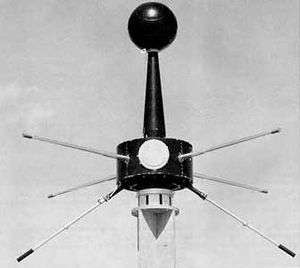Explorer 10
Explorer 10 (also known as Explorer X or P14) was an American Earth-orbital satellite that investigated Earth's magnetic fields and nearby plasma. Launched on March 25, 1961, it was an early mission in the Explorer program and was the first satellite to measure the "shock wave" generated by a solar flare.
 | |
| Mission type | Space plasma physics |
|---|---|
| Operator | NASA / OSSA |
| Harvard designation | 1961 Kappa 1 |
| COSPAR ID | 1961-010A |
| SATCAT no. | 98 |
| Mission duration | 52 hours |
| Spacecraft properties | |
| Manufacturer | Goddard Space Flight Center · MIT |
| Launch mass | 35 kilograms (77 lb) |
| Start of mission | |
| Launch date | March 25, 1961, 15:17:04 UTC[1] |
| Rocket | Thor DM-19 Delta |
| Launch site | Cape Canaveral LC-17A |
| End of mission | |
| Last contact | March 27, 1961 |
| Decay date | June 1, 1968 |
| Orbital parameters | |
| Reference system | Geocentric |
| Regime | Highly elliptical |
| Perigee altitude | 220 kilometers (140 mi) |
| Apogee altitude | 180,999 kilometers (112,468 mi) |
| Inclination | 33 degrees |
| Period | 83.50 hours |
| Epoch | March 25, 1961[2] |
| Instruments | |
| magnetometers, plasma probe | |
Explorers | |
Mission
The objective was to investigate the magnetic fields and plasma as the spacecraft passed through Earth's magnetosphere and into cislunar space. The satellite was launched into a highly-elliptical orbit and was spin-stabilized with a spin period of 0.548 s. The direction of its spin vector was 71 degrees right ascension and minus 15 degrees declination.
Because of the limited life of the spacecraft batteries, the only useful data were transmitted in real time for 52 hours on the ascending portion of the first orbit. The distance from the Earth when the last bit of useful information was transmitted was 42.3 Earth radii, and the local time at this point was 2200 h. All transmission ceased several hours later.
Design

Explorer 10 was a cylindrical, battery-powered spacecraft instrumented with two fluxgate magnetometers and one rubidium vapor magnetometer extending from the main spacecraft body, and a Faraday cup plasma probe. The magnetometers were produced by Goddard Space Flight Center, and the Massachusetts Institute of Technology provided the plasma probe.
Sun-Moon-Earth aspect sensor
The optical aspect sensor consisted of a Sun-Moon-Earth sensor and associated electronics. The Earth-Moon part of the sensor consisted of a fan field of vision, 3 degrees wide and 120 degrees long, which swept through the sky as the probe rotated in space. The appearance of the Moon or Earth in the sensor's field of view caused a step change in subcarrier frequency. The Sun part of the sensor consisted of a digital coded slit 2 deg wide and 100 deg long. The appearance of the Sun in the field of view of the slit caused a discrete frequency on the subcarrier which corresponded to the position of the Sun in the field of view.
References
- McDowell, Jonathan. "Launch Log". Jonathan's Space Page. Retrieved December 17, 2013.
- McDowell, Jonathan. "Satellite Catalog". Jonathan's Space Page. Retrieved December 17, 2013.
![]()
.png)